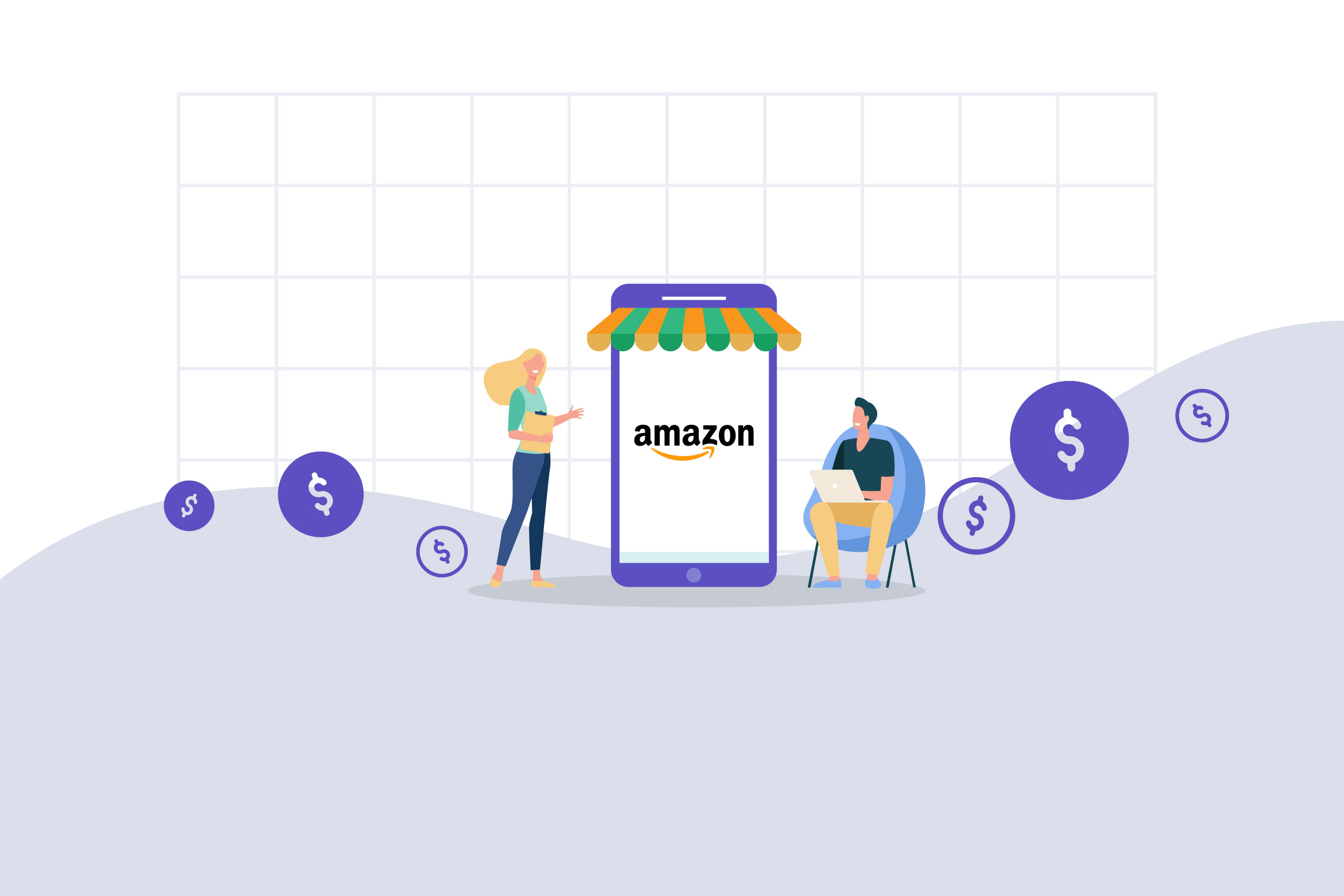AI Amazon Repricer
Boost your Amazon profits and avoid price wars with AI repricing
When it comes to selling on marketplaces, Amazon is the first thing that comes to mind for most.

When it comes to selling on marketplaces, Amazon is the first thing that comes to mind for most.
This comes as no surprise as Amazon offers sellers the chance to grab the attention of 89% of customers who say they are more likely to buy products from Amazon than other eCommerce websites. Whether you’re a small company wanting to build brand awareness, or an enterprise company looking to expand into an international market, there is no denying that Amazon is the front and center of eCommerce.
Before you get started, you should know that there are two options when it comes to selling on Amazon, yes two! You can either join as a seller on Amazon or as an Amazon vendor, as there is a big difference.
The first is an Amazon seller, which is the most commonly used option. It allows brands to use the platform as an additional sales channel to sell to customers.
The other is selling directly to Amazon. This is called an Amazon vendor, or what is known as a first-party seller. This means you are selling your product to Amazon and they sell it to customers.
The pros that come with being a first-party seller include;
But, there are a few cons that can make selling directly difficult;
Earning an invite is no walk in the park. Amazon takes this seriously, as your product will be tied to its brand. Amazon often selects businesses to join their program if they are;
To become a first-party seller, you need to:
To get an invite, you either have to hold a strong presence on the marketplace or have a website that is doing exceptionally well. This can be done by improving your search engine optimization (SEO) for your own website, as this will ensure you drive more traffic, improve trust and credibility, support content marketing, rank on the first page of Google (which is said to get over 90% of traffic), and potentially be seen by Amazon.
Secondly, improve your product listing optimization (PLO) for Amazon. PLO is similar to SEO as the purpose of it is to help you increase visibility, rank high on the Amazon search engine, increase the conversion rate, which helps generate sales and increase customer demand. You need to do keyword research, stick to Amazon’s 60-character limit for product titles, and have accurate product data.
About 56% of online consumers start their product searches on Amazon. This is the first stage of their shopping journey, so optimizing your listing and search terms can help your product reach customers on Amazon faster.
You can use PIM for eCommerce to store all of your product data. You can also store your marketing data such as keywords, SEO elements, and more to help you create optimized content that is informative SEO and PLO friendly, and accurate which will help your efforts for both your website and Amazon list. The more you work on this, the more visible your product will be which will increase the chances of you getting invited into Amazon Vendor.
Nearly 50% of Amazon shoppers listed competitive pricing as the main reason for purchasing off Amazon. You can use this information to gain popularity in the marketplace. You are competing for customers’ attention with many other brands, and you can gain a competitive edge by selling your products at a reasonable price that customers are willing to pay. You can adjust pricing either by; discounts or shipping costs or by repricing.
A branded store lets you customize a storefront on Amazon to showcase your brand’s product and story. This can bring in more traffic from Amazon search and detail pages, which ultimately drive shopper engagement and improve brand awareness.
You may have heard about the Buy Box as it is the end goal for most sellers on Amazon. If you make it onto the Buy Box, it means that Amazon has noticed your product, but it’s a win because it helps to drive more sales with customers. To get into the Buy Box, you need to;
Amazon Prime customers are known to spend more than regular customers. In fact, more than 100 million Prime members buy nearly double in comparison to non-members due to the Prime privileges. You can use this to your advantage to get your product out there and reach customers that have a higher chance of doing repeat purchases. This will help you bring in more sales, and can be a signal to Amazon that your product is popular thus adding you to the Buy Box and essentially inviting you to be a vendor.
Now that we have addressed a few ways to help you get a vendor’s invite, let’s get into how to successfully sell there to ensure this is the right thing for your business.
Right, now you have managed to become a successful third-party seller and you’ve received an invite to become a vendor, now what? While there are a number of benefits to becoming a first-party seller, there are a couple of things that may leave you at a disadvantage. Here are tips to help you change that.
When you get an invitation to sell directly to Amazon, it’s important to not go in with your complete catalog. Why? As we mentioned before, one of the cons is that they have complete control over the pricing, messaging, and logistics of the products you sell, and they won’t be seen as your products but Amazon’s products.
To avoid this, choose a certain number of products you want to sell as a vendor, and continue with selling as a third-party seller too. And, yes, you can have both accounts. For example, Steve Madden shoes have both accounts as they are a vendor, have an FBA model, and a third-party option. It is dependent on what the customer wants.
You can achieve this by splitting product ranges, using different SKUs for different programs, and using different models in international markets.
While you may want to add all of your best-selling products to the vendor platform, and Amazon would only take those specific products, it’s best to not upload all of your top-sellers. This is particularly important for SMBs. When you take your best products and sell them to Amazon, you won’t receive traffic to your own website; you won’t receive any brand recognition and you won’t be able to price them as you see fit, which can lead you to not getting the profit margin you had hoped for.
Instead, keep a balanced ratio of selling your best products as a vendor, so that you can minimize logistics and you can enjoy Amazon Marketing Services (AMS) as it helps vendors stand out and has the potential to drive traffic to product detail pages and branded pages. So, make sure you have a good balance.
When you become a vendor, Amazon will give you the option to do your shipping through them. This gives you access to Amazon Prime members, which can ultimately bring in more sales. Amazon FBA does come with fees and costs that you would want to avoid, but doing your own order fulfillment doesn’t market you to the Amazon Prime members so it is something you should consider. Additionally, you can choose Seller Fulfilled Prime (SFP), which allows you to have control of storing, packing, and shipping while also allowing you to utilize their Prime option, allowing you to reach Prime members.
But, like the vendor program, choosing the SFP route won’t be easy. There is a trial period that requires vendors to have a minimum of 300 orders and meet Amazon’s requirements such as;
Amazon is associated with the product and you need to ensure you are able to keep their customers happy and uphold their reputation. This is why it has such strict requirements.
When you join the vendor program, they will have inventory requirements that you need to meet at all times. And considering that most of the products on the vendor program are in high demand, it can cause a strain on inventory management, especially if you work alone. To alleviate the pressure, you may need to outsource production so that you can meet demands. This is especially the case if you’re also managing multiple sales channels.
Selling on various sales channels can be a challenging task, particularly when you want to move up the ladder and join exclusive programs such as selling to Amazon directly. But, it is doable, when you work on your product data to ensure you have product descriptions, product images, and relevant keywords that help you rank better on Amazon. This is why companies are investing in systems like PIM software to help make things easier to help them grow their brand on one of the most popular ecommerce platforms.
——
About the Author:
Plytix is one of the leading Product Information Management (PIM) tools on the market, specially designed for online retail. It is a single source of truth designed to help you manage content at scale and get your products to market faster.

Set up in minutes with the help of our customer success team, or reach out to our sales team for any questions. Start your 15-day free trial—no credit card needed!